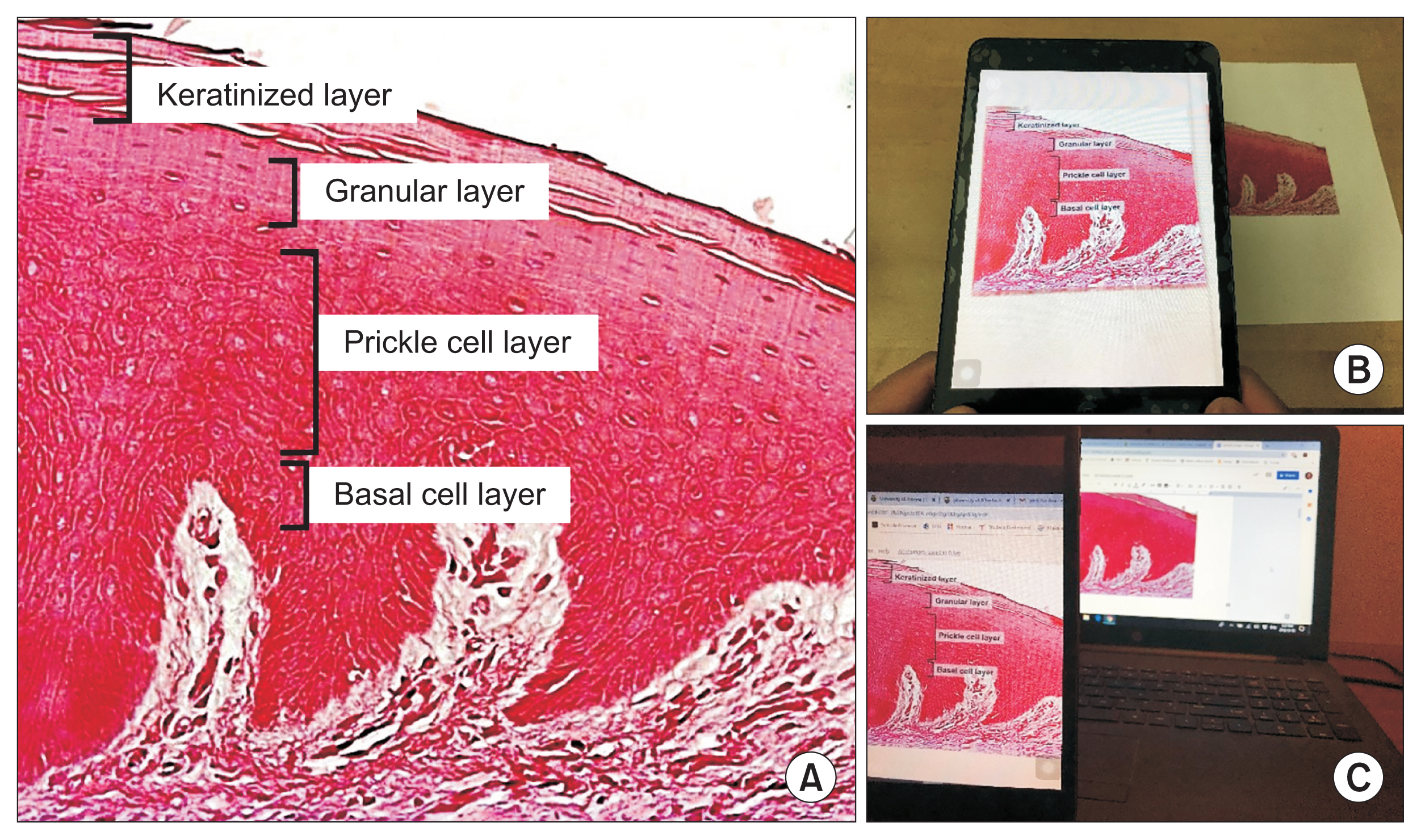Healthc Inform Res.
2020 Jul;26(3):238-242. 10.4258/hir.2020.26.3.238.
Augmented Reality Application to Develop a Learning Tool for Students: Transforming Cellphones into Flashcards
- Affiliations
-
- 1School of Dentistry, Faculty of Medicine and Dentistry, University of Alberta, Edmonton, AB, Canada
- KMID: 2505265
- DOI: http://doi.org/10.4258/hir.2020.26.3.238
Abstract
Objectives
Flashcards are one of the most popular and optimized ways to learn factual knowledge and improve memory performance. Students of modern age, who use smart technology and mobile devices in their daily lives, often lack the time and motivation to create and use flashcards effectively. We aim to use the inseparable relationship between university students and their smartphones to create new options for higher education, converting their cellphones into flashcards. We have used this new technology to develop a simple application (app) to convert the smart mobile devices of students into flashcards.
Methods
We have developed an augmented reality (AR) flashcard application using Unity3D, which requires the user to identify a target image. Once the target image is identified, it can be replaced by any other digital output, i.e., 2D image, 3D models, or videos. We used images of histological sections of oral mucosa, which dentistry students study as a part of an oral biology course.
Results
The AR flashcard application worked on both iOS and Android systems. It was able to detect the target image and replace it with the output image on the device screen.
Conclusions
Using this application, students will be able to independently learn and self-test their learning at their own convenience. Instructors can use the application to provide additional study aids for the students. Our application, which is being developed as a pilot project, will be expanded and applied as a learning tool for students studying dentistry at the University of Alberta.
Keyword
Figure
Cited by 1 articles
-
Implementing Augmented Reality to Facilitate the Learning of Oral Histology
Nazlee Sharmin, Ava K. Chow, Dominic Votta, Nathanial Maeda
Healthc Inform Res. 2022;28(2):170-175. doi: 10.4258/hir.2022.28.2.170.
Reference
-
References
1. Karpicke JD, Roediger HL 3rd. The critical importance of retrieval for learning. Science. 2008; 319(5865):966–8.
Article2. Bahrick HP, Hall LK. The importance of retrieval failures to long-term retention: a metacognitive explanation of the spacing effect. J Mem Lang. 2005; 52(4):566–77.
Article3. Lovelace EA. Metamemory: Monitoring future recall-ability during study. J Exp Psychol Learn Mem Cogn. 1984; 10(4):756–66.
Article4. Wissman KT, Rawson KA, Pyc MA. How and when do students use flashcards? Memory. 2012; 20(6):568–79.
Article5. Karpicke JD. Metacognitive control and strategy selection: deciding to practice retrieval during learning. J Exp Psychol Gen. 2009; 138(4):469–86.
Article6. Pyc MA, Rawson KA. Testing the retrieval effort hypothesis: Does greater difficulty correctly recalling information lead to higher levels of memory? J Mem Lang. 2009; 60(4):437–47.
Article7. Vaughn KE, Rawson KA. Diagnosing criterion-level effects on memory: what aspects of memory are enhanced by repeated retrieval? Psychol Sci. 2011; 22(9):1127–31.8. Galanek JD, Gierdowski DC, Christopher Brooks D. ECAR study of undergraduate students and information technology, 2018 [Internet]. Louisville (CO): Educause Center for Applied Research;2018. [cited at 2020 Jul 24]. Available from: https://library.educause.edu/~/media/files/library/2018/10/studentitstudy2018.pdf?la=en.9. Vega Garzon JC, Magrini ML, Galembeck E. Using augmented reality to teach and learn biochemistry. Biochem Mol Biol Educ. 2017; 45(5):417–20.10. Bimber O, Raskar R. Spatial augmented reality: merging real and virtual worlds. Wellesley (MA): A. K. Peters;2005.11. Shelton BE, Hedley NR. Exploring a cognitive basis for learning spatial relationships with augmented reality. Technol Instr Cogn Learn. 2004; 1(4):323–57.12. Waterworth EL, Waterworth JA. Focus, locus, and sensus: the three dimensions of virtual experience. Cyberpsychol Behav. 2001; 4(2):203–13.
Article13. Mayer RE. Multimedia learning. 2nd ed. New York (NY): Cambridge University Press;2009.14. Lee D, Yi JW, Hong J, Chai YJ, Kim HC, Kong HJ. Augmented reality to localize individual organ in surgical procedure. Healthc Inform Res. 2018; 24(4):394–401.
Article15. Henssen DJ, van den Heuvel L, De Jong G, Vorstenbosch MA, van Cappellen van Walsum AM, Van den Hurk MM, et al. Neuroanatomy learning: augmented reality vs. cross-sections. Anat Sci Educ. 2020; 13(3):353–65.
Article16. Garcia-Bonete MJ, Jensen M, Katona G. A practical guide to developing virtual and augmented reality exercises for teaching structural biology. Biochem Mol Biol Educ. 2019; 47(1):16–24.
Article17. Southworth MK, Silva JR, Silva JN. Use of extended realities in cardiology. Trends Cardiovasc Med. 2020; 30(3):143–8.
Article
- Full Text Links
- Actions
-
Cited
- CITED
-
- Close
- Share
- Similar articles
-
- Implementing Augmented Reality to Facilitate the Learning of Oral Histology
- Augmented Reality in Medicine
- The effect of utilizing augmented reality in a mobile application for sequential tooth carving by users
- The application of augmented reality for improving clinical skills: a scoping review
- Educational applications of metaverse: possibilities and limitations




